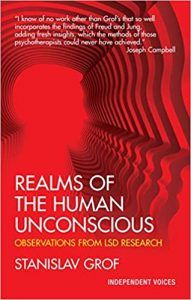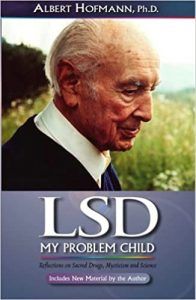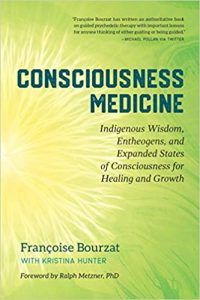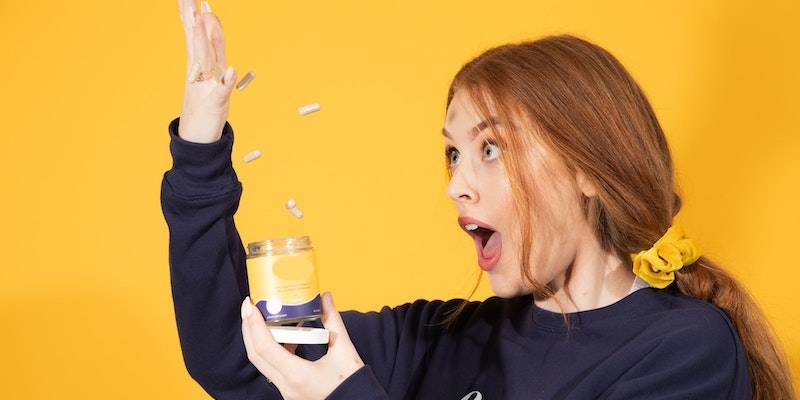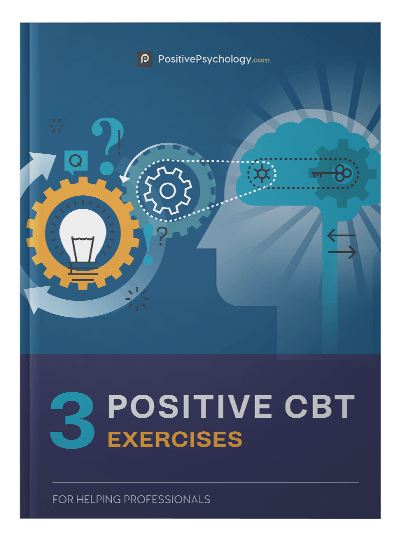Psychedelic-Assisted Therapy: 12 Findings & Training Options
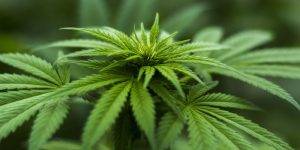 If any therapeutic approach were to raise an eyebrow or two, it would probably be psychedelic-assisted psychotherapy.
If any therapeutic approach were to raise an eyebrow or two, it would probably be psychedelic-assisted psychotherapy.
Therapy in itself can be intense, challenging, and unpredictable, so could adding hallucinogenic drugs into the mix really help the process?
The short answer is yes, quite possibly.
Unfortunately, the U.S. Controlled Substances Act in 1970 put the brakes on early research exploring psychedelic-assisted psychotherapy, but there has been a resurgence of clinical interest in recent years.
If you are open minded, we’ll take you on a trip through some ground-breaking research studies that explore the effectiveness and safety of psychedelic-assisted therapy to treat a range of mental health conditions.
Before you continue, we thought you might like to download our three Positive Psychology Exercises for free. These science-based exercises explore fundamental aspects of positive psychology, including strengths, values, and self-compassion, and will give you the tools to enhance the wellbeing of your clients, students, or employees.
This Article Contains:
What Is Psychedelic-Assisted Psychotherapy?
Psychedelic drugs have the ability to alter perception and consciousness, often provoking visual or auditory hallucinations and dream-like or “mystical” encounters (Nichols, 2016).
Even the term “psychedelic” sparked controversy when it was first used by psychiatrist Humphry Osmond in 1957 (Nichols, 2016). Osmond chose the term because it aptly married the Greek words psychē, meaning “mind” or “soul,” and dēloun, which means “to reveal” (Tanne, 2004).
The Oxford definition of psychedelics describes substances that lead to an “apparent expansion of consciousness,” which, in essence, celebrates their positive and potentially helpful mind-broadening potential – a view not welcomed by all the scientific community (Nichols, 2016).
Some drugs used in psychedelic-assisted therapy include (Schenberg, 2018):
- LSD — lysergic acid diethylamide
- MDMA — 3,4-methylenedioxymethamphetamine
- Ketamine — 2-(2-chlorophenyl)-2-(methylamino)cyclohexan-1-one
- Psilocybin — 4-phosphoryloxy-N,N-dimethyltryptamine
- Ibogaine — 12-methoxyibogamine
Psychedelics can offer an enchanting array of benefits for psychotherapy, such as:
- Facilitating positive, meaningful, or “mystical” psychological experiences
- Enhancing the therapeutic relationship
- Cultivating introspection and awareness of thoughts, feelings, and memories
- Helping the client process and regulate difficult emotions
- Enhancing cognitive flexibility and creativity (Bogenschutz et al., 2015; Doblin, 2002; Krediet et al., 2020; Nichols, 2016; Schenberg, 2018; Reiff et al., 2020)
Depending on the drug of choice, psychedelic-assisted therapy usually involves taking the drug a couple of times during a schedule of psychotherapeutic sessions (Schenberg, 2018). The therapist aims to provide a safe, nonjudgmental, and trusting space for the client throughout the process (Reiff et al., 2020).
The sessions where drugs are consumed are typically sandwiched between “preparatory” and “integrative” therapeutic sessions, providing a holding structure to prepare the client for the experience and help them process it afterward (Schenberg, 2018).
A trained mental health professional monitors the client while under the effects of the drugs (Schenberg, 2018). The client may listen to music or wear an eye mask, and they are advised to bring their awareness to thoughts, emotions, and memories. The psychedelic may deepen their insight into these experiences to facilitate change and personal growth (Garcia-Romeu & Richards, 2018; Schenberg, 2018; Reiff et al., 2020).
How Do Psilocybin and LSD Therapy Work?
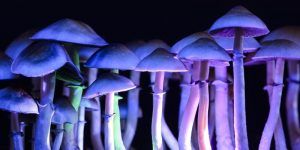
While other drugs used in psychedelic-assisted therapy such as ketamine or MDMA may provoke profound shifts in consciousness, these drugs do not act on the same neurochemical pathways that LSD and psilocybin do (Nichols, 2016).
Tryptamines come from the amino acid tryptophan and are often hallucinogenic (Hill & Thomas, 2011). Natural tryptamines include serotonin, ayahuasca (dimethyltryptamine), and psilocybin, recreationally found in magic ‘psilocybe’ mushrooms (Hill & Thomas, 2011).
LSD is the strongest hallucinogenic and is part of the tryptamine family. However, LSD is a synthetically made hallucinogen with a more elaborate chemical structure than psilocybin (Hill & Thomas, 2011). Within LSD, you’ll find the chemical structure of serotonin – a discovery that played an important part in the development of neuroscientific theories about the role of serotonin in the brain (Nichols, 2016).
LSD and psilocybin are primarily thought to act upon serotonin (5-HT) 2A receptors in the brain (Nichols, 2016). Serotonin plays a central role in mood and is intimately linked with happiness and wellbeing (Young, 2007).
The exact effects of psychedelics on psychotherapeutic outcomes remain somewhat elusive (Reiff et al., 2020). However, LSD and psilocybin therapy can provoke consciousness-widening “peak experiences” as well as painful experiences, which can bring about significant shifts in perspective, mood, and understanding (Nichols, 2016; Reiff et al., 2020).
Typically, the role of the therapist is to discuss the insights the client has gained during the experience in order to move toward long-lasting and meaningful change (Reiff et al., 2020).
Below is a fascinating TED talk from renowned psychopharmacologist Roland Griffiths about the pioneering work of the Johns Hopkins Center for Psychedelic & Consciousness Research and the transformative power of psilocybin.
Are psychedelics safe?
In standard doses, LSD and psilocybin (among other classic serotonergic hallucinogens) are generally regarded as safe in terms of their immediate effects on the human body and are largely nonaddictive because they don’t primarily target the brain’s dopamine (reward) pathways (Nichols, 2016).
However, psychedelic drugs can cause dangerous behavior, and high doses or chronic consumption can lead to serious physical and mental health problems (Nichols, 2016; Hill & Thomas, 2011). Newer synthetic (e.g., phenethylamine) hallucinogens can be very strong and surprisingly more harmful (Nichols, 2016).
Of course, psychedelic therapy is not for everyone. Among many other factors, personality, mental and physical health issues such as a history of psychosis, and other medications taken need to be carefully considered on an individual basis (Johnson, Griffiths, Hendricks, & Henningfield, 2018; Reiff et al., 2020).
People’s mindset and expectations about their experience on psychedelics, as well as the situation they’re in, can also profoundly shape psychedelic experiences (Nichols, 2016).
This is a central concern of psychedelic-assisted psychotherapy. Mentally preparing clients for the journey and having them take these drugs in a controlled and pleasant therapeutic setting are considerations that aim to encourage more positive psychological experiences (Nichols, 2016).
Is It Effective? 3 Fascinating Research Findings
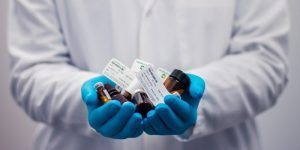
The following studies offer intriguing insights into the effectiveness and benefits of psychedelic-assisted therapy for a range of mental health conditions.
1. Meta-analysis exploring effects of psychedelic-assisted therapy
Meta-analyses calculate the size of an effect of one variable (e.g., LSD) on another variable (e.g., anxiety) by combining numerous studies. As a simple analogy, you might predict that hitting a golf ball with a golf club would have a much larger effect on the trajectory of the ball over a series of swings, compared to hitting it with a toothpick.
Luoma, Chwyl, Bathje, Davis, and Lancelotta (2020) tested the effect size of psychedelic-assisted therapy on a range of mental disorders. The analysis involved nine randomized placebo-controlled trials.
Luoma et al. (2020) found that psychedelic-assisted therapy was effective for treating post-traumatic stress disorder, unipolar depression, anxiety and depression linked to life-threatening illness, and social anxiety for autistic adults. The psychedelics were only taken a handful of times, and very few adverse effects were reported (Luoma et al., 2020).
Staggeringly, they found that people were 80% more likely to experience a positive outcome from psychedelic-assisted therapy when compared to the placebo treatment (Luoma et al., 2020).
2. A functional MRI study with psilocybin
Carhart-Harris et al. (2012) used fMRI scanning to explore whether psilocybin could help people access their memories and emotions. They compared brain scans of 10 participants when taking a placebo and when taking 2 milligrams of the drug intravenously in a saline solution (one week apart).
They found that psilocybin improved people’s ability to recall memories and increased the “vividness” and visual imagery of memories. Compared to placebo, psilocybin exclusively activated brain regions associated with sensory experiences and vision.
This study highlighted the potential of psilocybin for illuminating memories, perhaps allowing people to return to them and examine them in a way they are not normally able to. The researchers suggested psilocybin-assisted psychotherapy could be useful for depression, to help people reconnect with positive memories and shift negative thinking styles (Carhart-Harris et al., 2012).
3. Alcohol dependence and psilocybin-assisted therapy
Bogenschutz et al. (2015) tested the effectiveness of psilocybin-assisted therapy for a group of 10 people with alcohol dependence. The participants were also going through Motivational Enhancement Therapy and experienced one or two drug sessions, as well as preparatory and follow-up therapy sessions.
Self-reported abstinence from alcohol went up considerably following the psilocybin treatment, and these benefits were largely maintained at 36 weeks, with no adverse events reported.
Curiously, they found that more “mystical” psychedelic experiences on the drug predicted changes in drinking behavior. The researchers emphasized the need for more randomized controlled trials to see if these effects are replicated in larger samples.
Managing Depression, PTSD, & Anxiety: 3 Studies
Psychedelic-assisted therapy is proving to be particularly beneficial for treating post-traumatic stress disorder (PTSD), depression, and anxiety, often resulting in positive treatment outcomes when other therapies have been unsuccessful.
1. PTSD and MDMA
The U.S. Food and Drug Administration (FDA) has recognized MDMA as a breakthrough therapy (Multidisciplinary Association for Psychedelic Studies, 2017), showing promise of clinical efficacy for treating PTSD over other available therapies.
MDMA may be effective for PTSD because it can help people regulate negative emotions, particularly fear and anxiety associated with trauma (Doblin, 2002). MDMA is also linked with positive experiences such as self-acceptance and emotional stability and may help build trust in the therapeutic relationship (Krediet et al., 2020).
Mithoefer et al. (2019) combined findings from six randomized controlled trials that used MDMA-assisted psychotherapy to treat people with PTSD. MDMA was taken in two or three 8-hour therapy sessions roughly a month apart, after three preparatory (non-drug) sessions, and included three or four 90-minute follow-up sessions.
They found that MDMA-assisted psychotherapy led to a significant reduction in the severity of PTSD symptoms (e.g., re-experiencing, heightened arousal) compared to the control group and was generally well tolerated.
Remarkably, following two experimental sessions, more people in the MDMA treatment group than the control group ceased to meet the diagnostic criteria for PTSD (Mithoefer et al., 2019).
2. LSD and anxiety associated with life-threatening illnesses
A qualitative study by Gasser, Kirchner, and Passie (2015) explored people’s experiences of LSD-assisted psychotherapy to treat anxiety associated with a life-threatening illness.
Ten participants experienced six to eight sessions of psychotherapy in a three-month period. They took LSD twice, around 4–6 weeks apart, lasting 8–10 hours. An integrative follow-up talk was carried out the following morning.
They found that anxiety scores dropped significantly after treatment, and this was sustained 12 months following psychotherapy. Among a rich array of benefits, participants reported that the LSD experience helped them connect with their emotions and gain a new perspective on themselves and their experiences, and even improved their quality of life in the long term.
For some, experiencing intense emotions was difficult initially, but all participants could manage their responses, and any negative effects did not extend beyond the treatment sessions.
3. Psilocybin and treatment-resistant depression
Psilocybin for treatment-resistant depression is the second psychedelic-assisted therapy to be designated a breakthrough therapy by the FDA (COMPASS Pathways, 2018).
Carhart-Harris et al. (2018) tested whether psilocybin and psychological support were effective for treatment-resistant depression. Participants took the drug on two occasions, a week apart, and received psychological support before, during, and after the sessions. Nineteen participants completed all the assessments.
Psilocybin and psychological support significantly reduced depression and anxiety ratings at one-week, three-month, and six-month follow-ups, and again, no serious adverse events were reported.
Although there was no control condition here, these findings are exciting; even a few doses of psilocybin alongside psychological support could have relatively long-term therapeutic benefits for treatment-resistant depression.
How to Be a Psychedelic Therapist: 3 Training Options
Ketamine is currently the only regulated psychedelic drug that can be legally acquired “off-label” (i.e. used to treat conditions outside its original medical intent) by licensed clinicians for use in therapeutic settings.
Otherwise, psychedelic-assisted psychotherapy remains firmly in the realm of clinical research (Reiff et al., 2020).
If you wish to carry out psychedelic-assisted psychotherapy, you can gain training as part of a clinical trial. Below are some organizations running FDA-approved clinical trials, who also offer training courses:
- The Multidisciplinary Association for Psychedelic Studies (MAPS) offers an MDMA Therapy Training Program for qualified health professionals. This 100-hour clinical training program (plus an experiential elective) involves retreats, group work, and coursework. Tuition costs $5,000, and scholarships are available.
- COMPASS Pathways offers a therapeutic training program for registered mental health professionals involved in their FDA trials for psilocybin-assisted therapy for treatment-resistant depression. At the time of writing, you can get in touch with Jess Rose Stuart (Europe) or Batya Septimus (North America) with a CV and statement of interest to be considered for future programs.
- The Usona Institute also conducts clinical trials with psilocybin for depression, but applications for training are currently limited to researchers carrying out clinical trials. However, you can keep a lookout for future training opportunities on their website, publications, or newsletter.
If you’d like to gain a qualification in psychedelic-assisted psychotherapy that isn’t tied to a clinical trial, another route is the Certificate in Psychedelic-Assisted Therapies and Research from the California Institute of Integral Studies.
This course is open to therapeutic professionals and is taught by leading researchers, academics, therapists, psychologists, and psychiatrists in the field. A vast array of topics are included, such as psychedelic therapeutic models, transpersonal psychology, and psychedelic research.
The course covers half of the MAPS essential training to conduct MDMA-assisted psychotherapy in clinical settings – a big plus for those wanting to work in FDA clinical trials.
It is a course with its eye to the future, when this could be a legitimate therapy, but in the interim, it could help people get into the training programs for the FDA-approved clinical trials.
3 Interesting Books on the Topic
This is such an intriguing subject, that we found three books worth mentioning.
1. Realms of the Human Unconscious: Observations From LSD Research – Stanislav Grof
World-renowned psychiatrist Dr. Grof conducted decades of research into human consciousness and is one pioneer of transpersonal psychology.
This book digs into LSD research, exploring its potential uses in psychotherapy, psychiatry, and beyond.
Find the book on Amazon.
2. LSD My Problem Child: Reflections on Sacred Drugs, Mysticism and Science – Albert Hofmann
Dr. Hofmann was the chemist who first synthesized LSD and accidentally discovered its hallucinogenic effects by ingesting it himself.
The book documents his autobiographical experiences of LSD as a life-changing medical discovery.
Hofmann delves into the history and uses of LSD in psychiatry and its colorful past as a recreational drug.
Find the book on Amazon.
3. Consciousness Medicine: Indigenous Wisdom, Entheogens, and Expanded States of Consciousness for Healing and Growth – Françoise Bourzat and Kristina Hunter
Bourzat has over 30 years of experience as a counselor and consciousness guide with expertise in indigenous healing techniques.
Her extensive therapeutic work, grounded in indigenous traditions, is a highly rated resource for those wishing to expand their knowledge of the consciousness-shifting power of psychedelics.
Find the book on Amazon.
A Take-Home Message
Clinical research into psychedelic-assisted psychotherapy is picking up pace.
MDMA-assisted therapy for PTSD and psilocybin-assisted therapy for treatment-resistant depression are ones to watch, as both have achieved breakthrough therapy status with the FDA.
Although ingesting hallucinogens is not without risk, clinical research continues to show the borderline-miraculous potential of psychedelics to enhance psychotherapy for a diverse range of mental health conditions.
The relatively powerful and long-lasting positive effects of very few doses of psychedelics are celebrated as a key advantage of psychedelic-assisted psychotherapy, in contrast to daily medications frequently prescribed for mental health conditions.
Psychedelic-assisted psychotherapy (beyond the use of ketamine) may in the future be a legitimate psychotherapeutic training route for independent practitioners, once we are fully aware of the risks, limitations, and true potential of these fascinating hallucinogenic drugs.
We hope you enjoyed reading this article. Don’t forget to download our three Positive Psychology Exercises for free.
- Bogenschutz, M. P., Forcehimes, A. A., Pommy, J. A., Wilcox, C. E., Barbosa, P. C. R., & Strassman, R. J. (2015). Psilocybin-assisted treatment for alcohol dependence: A proof-of-concept study. Journal of Psychopharmacology, 29(3), 289–299.
- Bourzat, F., & Hunter, K. (2019). Consciousness medicine: Indigenous wisdom, entheogens, and expanded states of consciousness for healing and growth. North Atlantic Books.
- Carhart-Harris, R. L., Bolstridge, M., Day, C. M. J., Rucker, J., Watts, R., Erritzoe, D. E., … Nutt, D. J. (2018). Psilocybin with psychological support for treatment-resistant depression: Six-month follow-up. Psychopharmacology, 235(2), 399–408.
- Carhart-Harris, R. L., Leech, R., Williams, T. M., Erritzoe, D., Abbasi, N., Bargiotas, T., … Nutt, D. J. (2012). Implications for psychedelic-assisted psychotherapy: functional magnetic resonance imaging study with psilocybin. The British Journal of Psychiatry, 200, 238–244.
- COMPASS Pathways. (2018, October 23). COMPASS Pathways receives FDA breakthrough therapy designation for psilocybin therapy for treatment-resistant depression. Retrieved April 26, 2021, from https://compasspathways.com/compass-pathways-receives-fda-breakthrough-therapy-designation-for-psilocybin-therapy-for-treatment-resistant-depression/
- Doblin, R. (2002). A clinical plan for MDMA (ecstasy) in the treatment of posttraumatic stress disorder (PTSD): Partnering with the FDA. Journal of Psychoactive Drugs, 34(2), 185–194.
- Garcia-Romeu, A., & Richards, W. A. (2018). Current perspectives on psychedelic therapy: Use of serotonergic hallucinogens in clinical interventions. International Review of Psychiatry, 30(4), 291–316.
- Gasser, P., Kirchner, K., & Passie, T. (2015). LSD-assisted psychotherapy for anxiety associated with a life-threatening disease: A qualitative study of acute and sustained subjective effects. Journal of Psychopharmacology, 29(1), 57–68.
- Grof, S. (1996). Realms of the human unconscious: Observations from LSD Research. Souvenir Press.
- Hill, S. L., & Thomas, S. H. (2011). Clinical toxicology of newer recreational drugs. Clinical Toxicology, 49, 705–719.
- Hofmann, A. (2009). LSD: My problem child: Reflections on sacred drugs, mysticism and science (4th ed.). MAPS.org.
- Johnson, M. W., Griffiths, R. R., Hendricks, P. S., & Henningfield, J. E. (2018). The abuse potential of medical psilocybin according to the 8 factors of the Controlled Substances Act. Neuropharmacology, 142, 143–166.
- Krediet, E., Bostoen, T., Breeksema, J., van Schagen, A., Passie, T., & Vermetten, E. (2020). Reviewing the potential of psychedelics for the treatment of PTSD. International Journal of Neuropsychopharmacology, 23(6), 385–400.
- Luoma, J. B., Chwyl, C., Bathje, G. J., Davis, A. K., & Lancelotta, R. (2020). A meta-analysis of placebo-controlled trials of psychedelic-assisted therapy. Journal of Psychoactive Drugs, 52(4), 289–299.
- Mithoefer, M. C., Feduccia, A. A., Jerome, L., Mithoefer, A., Wagner, M., Walsh, Z., … Doblin, R. (2019). MDMA-assisted psychotherapy for treatment of PTSD: Study design and rationale for phase 3 trials based on pooled analysis of six phase 2 randomized controlled trials. Psychopharmacology, 236, 2735–2745.
- Multidisciplinary Association for Psychedelic Studies. (2017, August 26). Press release: FDA grants breakthrough therapy designation for MDMA-assisted psychotherapy for PTSD, agrees on special protocol assessment for phase 3 trials. Retrieved April 26, 2021, from https://maps.org/news/media/6786-press-release-fda-grants-breakthrough-therapy-designation-for-mdma-assisted-psychotherapy-for-ptsd,-agrees-on-special-protocol-assessment-for-phase-3-trials
- Nichols, D. E. (2016). Psychedelics. Pharmacological Reviews, 68(2), 264–355.
- Reiff, C. M., Richman, E. E., Nemeroff, C. B., Carpenter, L. L., Widge, A. S., Rodriguez, C. I., … Work Group on Biomarkers and Novel Treatments, a Division of the American Psychiatric Association Council of Research. (2020). Psychedelics and psychedelic-assisted psychotherapy. American Journal of Psychiatry, 177(5), 391–410.
- Schenberg, E. E. (2018). Psychedelic-assisted psychotherapy: A paradigm shift in psychiatric research and development. Frontiers in Pharmacology, 9, 733.
- Tanne, J. H. (2004). Humphry Osmond. British Medical Journal, 328(7441), 713.
- Young, S. N. (2007). How to increase serotonin in the human brain without drugs. Journal of Psychiatry & Neuroscience, 32(6), 394–399.
Read other articles by their category
- Body & Brain (41)
- Coaching & Application (49)
- Compassion (27)
- Counseling (46)
- Emotional Intelligence (23)
- Gratitude (16)
- Grief & Bereavement (19)
- Happiness & SWB (35)
- Meaning & Values (26)
- Meditation (21)
- Mindfulness (42)
- Motivation & Goals (42)
- Optimism & Mindset (33)
- Positive CBT (24)
- Positive Communication (21)
- Positive Education (41)
- Positive Emotions (28)
- Positive Psychology (33)
- Positive Workplace (38)
- Relationships (31)
- Resilience & Coping (33)
- Self Awareness (21)
- Self Esteem (38)
- Software & Apps (23)
- Strengths & Virtues (28)
- Stress & Burnout Prevention (27)
- Theory & Books (42)
- Therapy Exercises (30)
- Types of Therapy (53)

